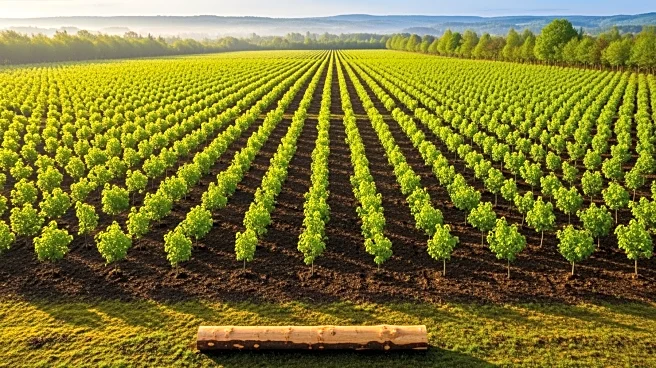What's Happening?
Forestry England has announced plans to create a new 102-hectare woodland on the edge of the Lincolnshire Wolds National Landscape. This initiative marks the fifth new site acquired by the agency in Lincolnshire since
2024, bringing the total area of new woodland to 965 hectares. The woodland, located near the village of Hagworthingham, will feature a mix of tree species and serve as a habitat for wildlife. Once established, it will be open for public exploration and enjoyment. The project aims to provide a sustainable supply of UK timber, supporting a greener economy. Forestry England plans to share early design proposals in spring 2026 and will invite local residents to provide feedback before planting begins.
Why It's Important?
The creation of new woodlands by Forestry England is significant for several reasons. It addresses the current lack of woodlands in parts of England, particularly in Lincolnshire, enhancing biodiversity and providing vital habitats for wildlife. Additionally, these woodlands contribute to carbon absorption, playing a role in climate change mitigation. The sustainable timber supply from these woodlands supports the UK's green economy, reducing reliance on imported timber and promoting local industry. The initiative also offers recreational opportunities for the public, fostering a connection with nature and promoting mental well-being.
What's Next?
Forestry England will present early design proposals for the new woodland in spring 2026, allowing local residents to share their views before planting begins. This engagement process is crucial for ensuring community support and addressing any concerns. As the woodland develops, it will be important to monitor its impact on local wildlife and the environment. The success of this project could lead to further woodland creation initiatives across the UK, enhancing national efforts towards sustainability and environmental conservation.
Beyond the Headlines
The establishment of new woodlands has broader implications beyond environmental benefits. It reflects a growing trend towards sustainable land management and conservation efforts in the UK. This project could serve as a model for other regions, demonstrating the benefits of integrating ecological considerations into land use planning. Additionally, the initiative highlights the importance of community involvement in environmental projects, ensuring that local needs and perspectives are considered in decision-making processes.














